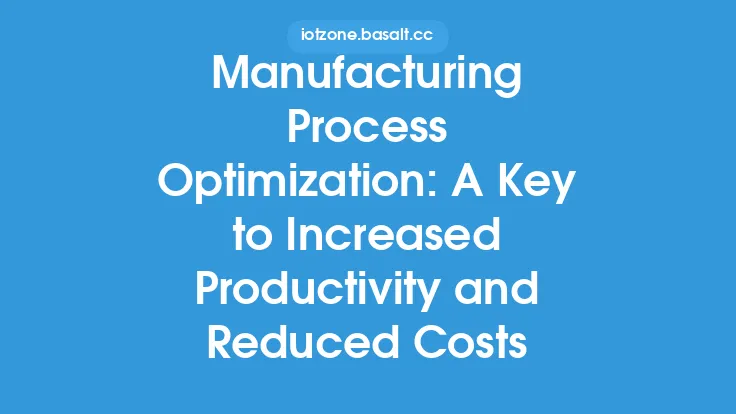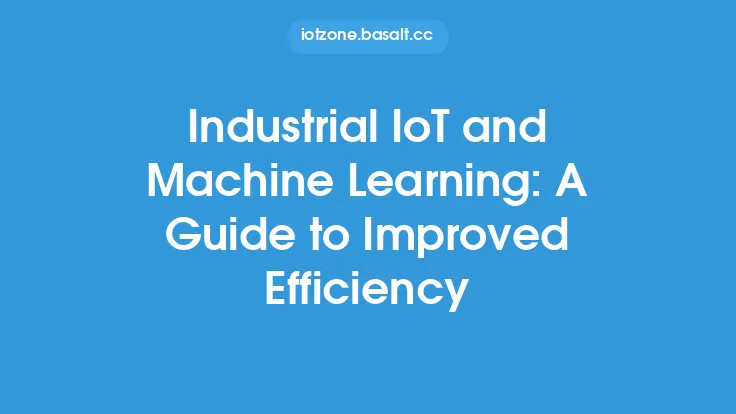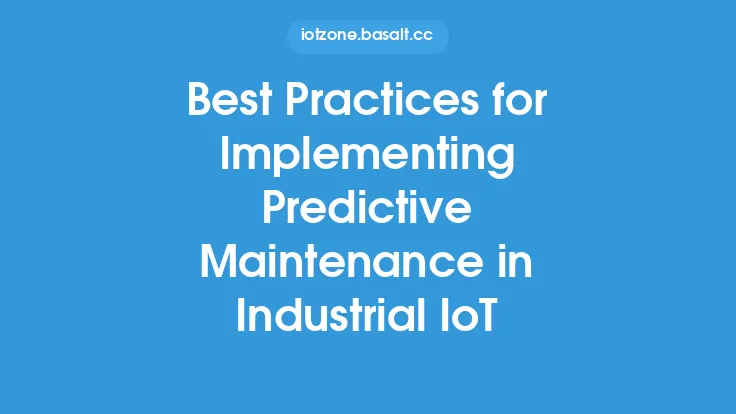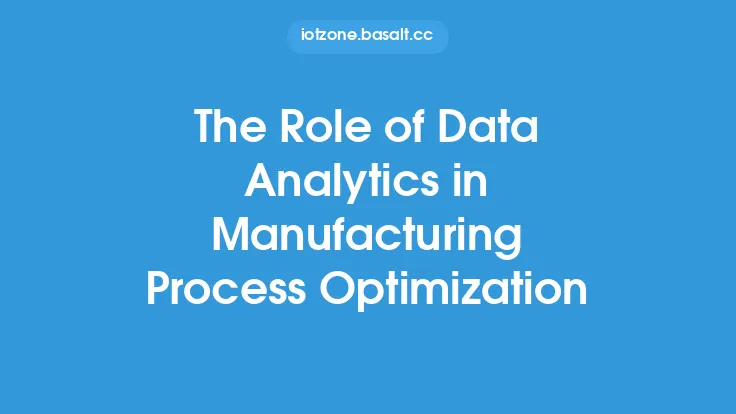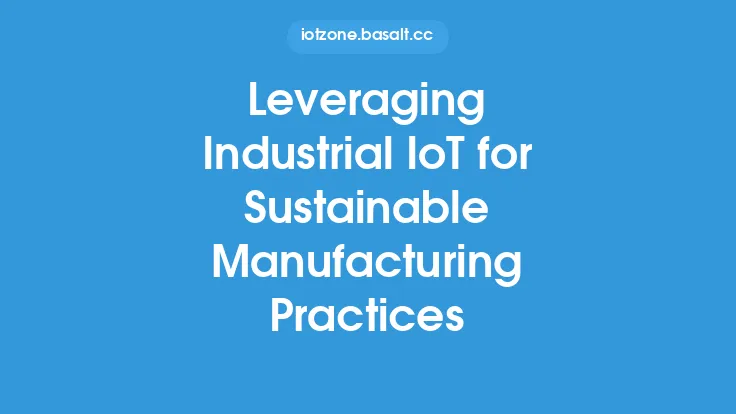Implementing Industrial IoT for manufacturing process optimization is a complex task that requires careful planning, execution, and maintenance. The Industrial Internet of Things (IIoT) refers to the integration of physical devices, sensors, and software to collect and analyze data, with the goal of improving manufacturing processes and increasing efficiency. In this article, we will explore the key steps and considerations for implementing IIoT in manufacturing, as well as the benefits and challenges associated with this technology.
Introduction to Industrial IoT
Industrial IoT is a subset of the Internet of Things (IoT), which refers to the network of physical devices, vehicles, home appliances, and other items that are embedded with sensors, software, and connectivity, allowing them to collect and exchange data. In the context of manufacturing, IIoT involves the use of sensors, actuators, and other devices to collect data on equipment performance, production processes, and product quality. This data is then analyzed and used to optimize manufacturing processes, improve product quality, and reduce costs.
Key Components of Industrial IoT
There are several key components of IIoT that are essential for manufacturing process optimization. These include:
- Sensors and devices: These are used to collect data on equipment performance, production processes, and product quality. Examples of sensors and devices used in IIoT include temperature sensors, pressure sensors, vibration sensors, and cameras.
- Communication protocols: These are used to enable communication between devices and systems. Examples of communication protocols used in IIoT include MQTT, CoAP, and HTTP.
- Data analytics software: This is used to analyze the data collected by sensors and devices, and to provide insights and recommendations for process optimization. Examples of data analytics software used in IIoT include machine learning algorithms, statistical process control, and data visualization tools.
- Cloud or edge computing: This is used to store and process the large amounts of data generated by IIoT devices and systems. Cloud computing refers to the use of remote servers and data centers to store and process data, while edge computing refers to the use of local devices and servers to store and process data.
Implementing Industrial IoT
Implementing IIoT in manufacturing requires careful planning and execution. The following steps are essential for a successful IIoT implementation:
- Define the goals and objectives of the IIoT project: This includes identifying the specific manufacturing processes that will be optimized, and the key performance indicators (KPIs) that will be used to measure success.
- Conduct a thorough assessment of the manufacturing process: This includes identifying the equipment, devices, and systems that will be used in the IIoT project, and assessing the current state of the manufacturing process.
- Develop a detailed project plan: This includes identifying the resources and budget required for the project, and developing a timeline for implementation.
- Install and configure IIoT devices and systems: This includes installing sensors, devices, and communication protocols, and configuring data analytics software and cloud or edge computing infrastructure.
- Test and validate the IIoT system: This includes testing the IIoT system to ensure that it is functioning as expected, and validating the data and insights generated by the system.
Benefits of Industrial IoT
The benefits of IIoT in manufacturing are numerous and well-documented. These include:
- Improved product quality: IIoT enables real-time monitoring and control of manufacturing processes, which can help to improve product quality and reduce defects.
- Increased efficiency: IIoT enables the optimization of manufacturing processes, which can help to increase efficiency and reduce waste.
- Reduced costs: IIoT enables the reduction of energy consumption, maintenance costs, and other expenses associated with manufacturing.
- Improved safety: IIoT enables real-time monitoring of equipment and processes, which can help to improve safety and reduce the risk of accidents.
Challenges and Limitations of Industrial IoT
While IIoT offers many benefits, there are also several challenges and limitations associated with this technology. These include:
- Security risks: IIoT devices and systems can be vulnerable to cyber attacks and data breaches, which can compromise the security of the manufacturing process.
- Interoperability issues: IIoT devices and systems from different manufacturers may not be compatible, which can make it difficult to integrate them into a single system.
- Data management: IIoT generates large amounts of data, which can be difficult to manage and analyze.
- Cost and complexity: IIoT can be expensive and complex to implement, which can make it difficult for some manufacturers to adopt this technology.
Best Practices for Implementing Industrial IoT
To ensure a successful IIoT implementation, manufacturers should follow several best practices. These include:
- Develop a clear understanding of the manufacturing process and the goals of the IIoT project.
- Conduct a thorough assessment of the manufacturing process and identify areas for improvement.
- Develop a detailed project plan and timeline.
- Install and configure IIoT devices and systems carefully.
- Test and validate the IIoT system thoroughly.
- Provide training and support to employees on the use of IIoT devices and systems.
- Continuously monitor and evaluate the performance of the IIoT system and make adjustments as needed.
Future of Industrial IoT
The future of IIoT in manufacturing is exciting and rapidly evolving. Advances in technologies such as artificial intelligence, machine learning, and edge computing are enabling new applications and use cases for IIoT. These include:
- Predictive maintenance: IIoT enables the use of machine learning algorithms to predict when equipment is likely to fail, which can help to reduce downtime and improve maintenance efficiency.
- Quality control: IIoT enables the use of computer vision and other technologies to inspect products and detect defects, which can help to improve product quality and reduce waste.
- Supply chain optimization: IIoT enables the use of real-time data and analytics to optimize supply chain operations, which can help to improve efficiency and reduce costs.
Conclusion
Implementing Industrial IoT for manufacturing process optimization is a complex task that requires careful planning, execution, and maintenance. By following the steps and best practices outlined in this article, manufacturers can ensure a successful IIoT implementation and achieve the many benefits associated with this technology. As IIoT continues to evolve and improve, we can expect to see new and innovative applications of this technology in manufacturing, which will help to drive efficiency, productivity, and competitiveness in the industry.
